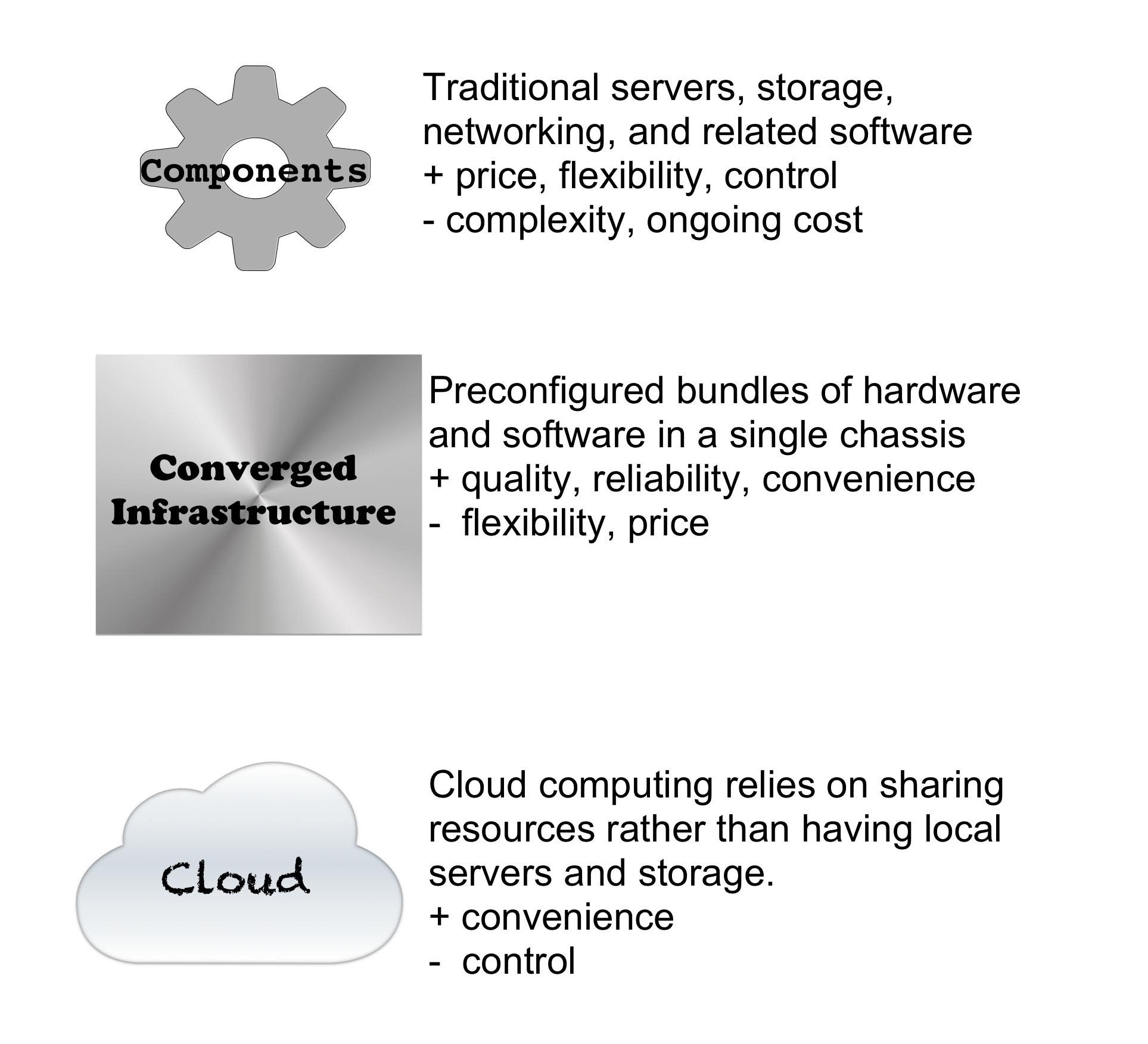How has the Cloud changed the way companies buy computer equipment?
We recently completed a project about the growing adoption of converged infrastructure technology in data centers worldwide. We talked to decision-makers to better understand what drives data center equipment purchasing decisions and typical situations in which enterprises and service providers chose converged infrastructure solutions vs. cloud offerings vs. traditional servers, storage, and network technology products (components).
Nearly everyone is currently using component-based infrastructure. Many organizations are exploring moving certain workloads onto the converged infrastructure solutions and/or into the cloud.
“Converged infrastructure (CI) is an approach to data center management that relies on a specific vendor and the vendor’s partners to provide pre-configured bundles of hardware and software in a single chassis.”
Top factors driving computing infrastructure choices
When making data center infrastructure decisions, organizations look at a number of different factors. The top factors were:
- Quality / Reliability - no one wanted to get a call at 3 a.m. because something important that they were responsible for got broken. Avoidance of downtime and inadequate performance were frequently top decision-making criteria, especially with mission-critical workloads. Relationship with their supplier was frequently considered in making datacenter equipment decisions. In many situations, organizations chose more expensive equipment to ensure quality and reliability of their infrastructure vs. the lowest cost.
- Price - generally speaking, computer equipment decisions are highly dependent on price / performance. Detailed requests for proposals (RFPs) were frequently developed to objectively compare and evaluate vendors. A vendor with the lowest price for an adequately configured system generally had an advantage.
- Convenience - the cloud revolution is largely based on convenience. Companies find it much more convenient to rent computing resources as and when they need them. No need to plan for capacity. No need to hire and train people to stay on top of the latest technologies. Today, one can just rent applications or raw computing resources whenever they are needed.
Overall, data center IT equipment decisions were a balancing act between quality, price, and convenience.
Cloud provides the ultimate convenience
Whenever organizations wanted convenience, with quality and price playing supporting roles, they would go to the cloud. Cloud solutions were not optimized for specific workloads. Delays were frequently introduced by off-premise hosting with no guaranteed service-level agreements (SLAs) committed by cloud service providers. Stringent security, confidentiality, and data residency requirements were almost impossible to enforce.
Components deliver the best price
When organizations focused on price, they went with components. With components, they could tinker and optimize their configuration to their specific need, to obtain the maximum price/performance at the lowest component price. Unfortunately, with infinite flexibility comes high level of complexity both in initial system design and on-going maintenance and updates. Therefore, organizations that went with components needed on-going higher level IT expertise to optimize their system's initial configuration as well as ongoing operation, and maintenance.
Converged infrastructure provides the best quality
When organizations wanted top quality, they invested in converged infrastructure. With converged infrastructure, buyers were guaranteed a high-quality pre-configured solution for their specific needs without having to invest substantial IT expertise in designing and maintaining the system. The vendor offered design and lifecycle maintenance of the aggregated solution. The converged solution may not have been 100% optimized for the specific workloads and it might have been more expensive than a component-based solution designed for specific workloads, but it was a top-quality, reliable solution that was guaranteed to work for the supported life of the equipment.
Converged infrastructure solutions are particularly appealing when large quantities of IT equipment are necessary, such as a datacenter move, an establishment of a duplicate datacenter for business continuity/disaster recovery purposes. large mission-critical application rollout (e.g. Enterprise Resource Planning (ERP) deployment, large Virtual Desktop Initiatives. The bigger the deployment, the more likely are the possibilities of miscommunications, delays, or mistakes. When timelines are tight, with little or no room for failure, getting a vendor to shoulder some of the overall project risk is quite appealing for business-savvy IT executives. Below is the chart summarizing what drives converged infrastructure (CI) investments and typical procurement process.
Expansion is driving most of Converged Infrastructure investments.
How is it going to play out longer term - will convenience or quality win?
Depending on the business needs and/or applications, convenience and quality are in a neck-in-neck race. For mission-critical applications at larger companies, converged infrastructure appears to be the best approach. For non-mission-critical workloads with unpredictable capacity needs or for smaller companies, Cloud can't be beat.
With prices of computer technology continuing to decline, the price premiums paid for converged infrastructure solutions are now within reach at many enterprises, service providers, and even mid-sized businesses. With ever-increasing importance of uptime for mission-critical workloads and need for increased business agility, more and more organizations are opting for converged infrastructure solutions vs. buying their infrastructure in components. Converged infrastructure solutions enable organizations to simplify and standardize, while retaining security, performance, and control (all downsides to Cloud solutions).
Investments in Converged Infrastructure expected to grow rapidly, primarily at the expense of components.
As our study was focused on Converged Infrastructure, we mostly interviewed decision-makers from larger organizations, most of whom plan to invest in Converged Infrastructure equipment in the next 3 years. For smaller organizations, the expectations for workload distribution is likely quite different, as Cloud delivery should be appealing, especially when software application vendors deliver their applications as a service (SaaS) using the Cloud infrastructure as the method of delivery. But this is a topic for another blog post.
What is your organization doing for your infrastructure needs?
Components, Converged Infrastructure or Cloud?
What are your thoughts and plans for the three alternatives?



